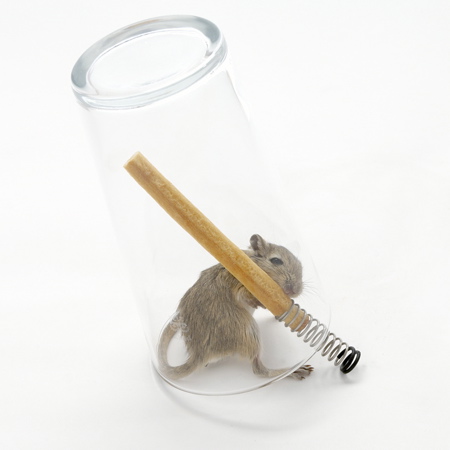Designer Roger Arquer has created a series of conceptual mousetraps that are intended "only to catch mice, not to kill them".
The four different traps - including Mouse in a Pint (top image) and Mouse in a Light Bulb (above) - are each made of everyday household items.
Arquer first developed the project in 2004 but these images are brand new and have not been published before. Above: Mouse in a Planting Pot. Below: Mouse in a Bottle
Arquer previously designed the Fish Bowls that were one of the most popular stories on Dezeen in the last few months.
Here's some text from Arquer:
--
Mousetraps
By Roger Arquer
These traps have been developed only to catch mice, not to kill them. It leaves up to the catcher the future of the mouse. The materials and the mechanics used are not aggressive, which makes it a friendly mousetrap. Clear glass, metal springs, paper clips, metal nut.
The concept was developed for a very simple, elegant and efficient way to catch mice. They are almost not being seen as traps, but as altered objects to be used for another reason. Once the mice problem is solved, the objects can be used again for its original function. These are generic clear glass objects that we have at home: a pint glass, a light bulb, a bottle and a planting pot.
Mouse in a Pint (above) is a beer glass upside down. It has a breadstick attached to a spring, tilting the glass so the mouse can get in. Once the breadstick is being nibbled, it breaks and the glass collapses, keeping the mouse inside.
Mouse in a Light Bulb (above) is a cut big light bulb with a heavy weigh in the bottom. The container is positioned horizontal with the nut, held by a paper clip. Once the mouse steps in, the nut is released and the light bulb tilts straight up, catching the mouse inside. Of course, this one can’t be reused as light bulb again.
Mouse in a Bottle (above) is a medium size soy sauce bottle. This is positioned horizontally with a tapered spring in the neck. The mouse squeezes in, expanding the end of the spring, to be able to get inside the bottle. Once inside, it cannot go back out because it can not expand the spring from inside. It works like a lobster trap or a Chinese finger trap.
Mouse in a Planting Pot (above) is a glass planting pot which has a long spring attached on the top going down outside. Once the mouse climbs up and goes at the end of the spring, the spring bends in and the mouse falls inside the container, when it releases the spring. It gets caught since the spring has returned to its original position.

